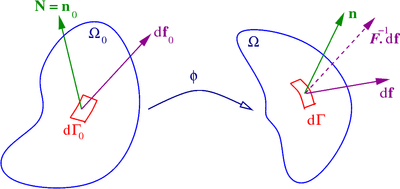Stress measures
The most commonly used measure of stress is the Cauchy stress tensor, often called simply the stress tensor or "true stress". However, several other measures of stress can be defined.[1][2][3] Some such stress measures that are widely used in continuum mechanics, particularly in the computational context, are:
- The Kirchhoff stress ().
- The Nominal stress ().
- The first Piola-Kirchhoff stress (). This stress tensor is the transpose of the nominal stress ().
- The second Piola-Kirchhoff stress or PK2 stress ().
- The Biot stress ()
Definitions of stress measures
Consider the situation shown in the following figure. The following definitions use the notations shown in the figure.
 Quantities used in the definition of stress measures |
In the reference configuration , the outward normal to a surface element is and the traction acting on that surface is leading to a force vector . In the deformed configuration , the surface element changes to with outward normal and traction vector leading to a force . Note that this surface can either be a hypothetical cut inside the body or an actual surface. The quantity is the deformation gradient tensor, is its determinant.
Cauchy stress
The Cauchy stress (or true stress) is a measure of the force acting on an element of area in the deformed configuration. This tensor is symmetric and is defined via
or
where is the traction and is the normal to the surface on which the traction acts.
Kirchhoff stress
The quantity is called the Kirchhoff stress tensor and is used widely in numerical algorithms in metal plasticity (where there is no change in volume during plastic deformation).
Nominal stress/First Piola-Kirchhoff stress
The nominal stress is the transpose of the first Piola-Kirchhoff stress (PK1 stress) and is defined via
or
This stress is unsymmetric and is a two point tensor like the deformation gradient. This is because it relates the force in the deformed configuration to an oriented area vector in the reference configuration.
Second Piola-Kirchhoff stress
If we pull back to the reference configuration, we have
or,
The PK2 stress () is symmetric and is defined via the relation
Therefore,
Biot stress
The Biot stress is useful because it is energy conjugate to the right stretch tensor . The Biot stress is defined as the symmetric part of the tensor where is the rotation tensor obtained from a polar decomposition of the deformation gradient. Therefore the Biot stress tensor is defined as
The Biot stress is also called the Jaumann stress.
The quantity does not have any physical interpretation. However, the unsymmetrized Biot stress has the interpretation
Relations between stress measures
Relations between Cauchy stress and nominal stress
From Nanson's formula relating areas in the reference and deformed configurations:
Now,
Hence,
or,
or,
In index notation,
Therefore,
Note that and are not symmetric because is not symmetric.
Relations between nominal stress and second P-K stress
Recall that
and
Therefore,
or (using the symmetry of ),
In index notation,
Alternatively, we can write
Relations between Cauchy stress and second P-K stress
Recall that
In terms of the 2nd PK stress, we have
Therefore,
In index notation,
Since the Cauchy stress (and hence the Kirchhoff stress) is symmetric, the 2nd PK stress is also symmetric.
Alternatively, we can write
or,
Clearly, from definition of the push-forward and pull-back operations, we have
and
Therefore, is the pull back of by and is the push forward of .
See also
- Stress (physics)
- Finite strain theory
- Continuum mechanics
- Hyperelastic material
- Cauchy elastic material
References
- ↑ J. Bonet and R. W. Wood, Nonlinear Continuum Mechanics for Finite Element Analysis, Cambridge University Press.
- ↑ R. W. Ogden, 1984, Non-linear Elastic Deformations, Dover.
- ↑ L. D. Landau, E. M. Lifshitz, Theory of Elasticity, third edition